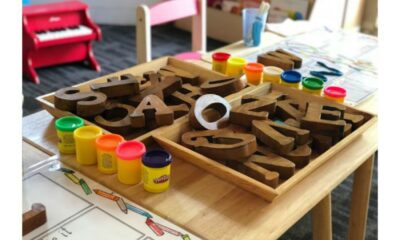Education
Mastering Classroom Management: Tips for Teachers

Effective classroom management is essential for creating a productive learning environment. With the right strategies, teachers can maintain order, foster student engagement, and minimize disruptions. Here are some tips to help teachers master classroom management and create a positive atmosphere for their students.
1. Establish Clear Rules and Expectations
One of the first steps in managing a classroom is setting clear rules and expectations. Clearly defined guidelines help students understand what is expected of them and the consequences of not following the rules. Create a list of classroom rules that are simple, specific, and easy to understand. These rules should cover behavior, participation, and respect for others. Make sure to discuss these rules with your students at the beginning of the school year and periodically review them. Establish consistent routines for daily activities. Having a predictable schedule helps students know what to expect and reduces uncertainty. Routines can include procedures for entering the classroom, transitioning between activities, and completing assignments.
2. Use Positive Reinforcement
Positive reinforcement is a powerful tool for encouraging good behavior and motivating students. By recognizing and rewarding positive actions, teachers can create a supportive and encouraging classroom environment. Praise students for their efforts and achievements. Acknowledging students’ hard work and accomplishments can boost their confidence and encourage them to continue striving for success. Be specific in your praise, highlighting exactly what the student did well. Implement a reward system to motivate students. This can include tangible rewards such as stickers, certificates, or small prizes, as well as intangible rewards like extra free time or special privileges. Reward systems can be individual or group-based, depending on what works best for your classroom. Focus on positive behaviors rather than negative ones. Instead of constantly pointing out what students are doing wrong, emphasize and reward the behaviors you want to see. This approach helps to shift the classroom dynamic towards a more positive atmosphere.
3. Incorporate Technology
Incorporating technology into your classroom management strategy can streamline processes and enhance student engagement. Various tools and resources are available to help teachers manage their classrooms more effectively. Utilize classroom management software to track student behavior, attendance, and academic progress. This software can provide valuable insights into student performance and help you identify areas that need improvement. Additionally, it can simplify communication with parents and guardians. Integrate interactive tools and apps to engage students. Technology can make learning more interactive and fun, keeping students interested and focused. Use educational apps, online quizzes, and interactive whiteboards to enhance your lessons and capture students’ attention.
4. Build Strong Relationships with Students
Building strong relationships with your students is crucial for effective classroom management. When students feel respected and valued, they are more likely to engage positively in the classroom. Take the time to get to know your students individually. Learn about their interests, strengths, and challenges. This information can help you tailor your teaching approach to meet their needs and build rapport. Show empathy and understanding. Recognize that students may face various challenges outside of school that can affect their behavior and performance. Being empathetic and supportive can help you connect with students on a deeper level. Encourage open communication. Create an environment where students feel comfortable expressing their thoughts and concerns. Actively listen to what they have to say and respond thoughtfully. This openness can foster trust and mutual respect.
5. Manage Classroom Transitions Smoothly
Transitions between activities can be challenging and often lead to disruptions. Managing these transitions smoothly can help maintain order and keep students focused. Plan and communicate transitions clearly. Before starting a new activity, explain what is expected and what students need to do. Clear instructions can help minimize confusion and ensure a smooth transition. Use signals or cues to indicate transitions. Establishing a consistent signal, such as a hand clap or a visual cue, can alert students that it’s time to switch activities. This consistency helps students know what to expect and respond quickly. Provide structured activities during transitions. Having a set task or routine during transitions can keep students occupied and reduce the likelihood of disruptive behavior. For example, you could assign a quick review question or a brief reflection exercise.
Conclusion
By implementing these tips, teachers can create a well-managed classroom that promotes learning and positive behavior. Whether it’s through establishing clear rules, using positive reinforcement, incorporating technology, building strong relationships, or managing transitions, effective classroom management is within reach.
-

 Sports4 weeks ago
Sports4 weeks agoFIFA Club World Cup 2025: Complete List of Qualified Teams and Groups
-

 Sports3 weeks ago
Sports3 weeks agoAl Ahly vs Inter Miami, 2025 FIFA Club World Cup – Preview, Prediction, Predicted Lineups and How to Watch
-
Health2 weeks ago
Back to Roots: Ayurveda Offers Natural Cure for Common Hair Woes
-

 Tech2 weeks ago
Tech2 weeks agoFrom Soil to Silicon: The Rise of Agriculture AI and Drone Innovations in 2025
-

 Sports3 weeks ago
Sports3 weeks agoFIVB Men’s Volleyball Nations League 2025: Full Schedule, Fixtures, Format, Teams, Pools and How to Watch
-

 Startup3 weeks ago
Startup3 weeks agoHow Instagram Is Driving Global Social Media Marketing Trends
-

 Television4 weeks ago
Television4 weeks agoTribeca Festival 2025: Date, Time, Lineups, Performances, Tickets and How to Watch
-

 Sports3 weeks ago
Sports3 weeks agoWorld Judo Championships 2025: Full Schedule, Date, Time, Key Athletes and How to Watch














